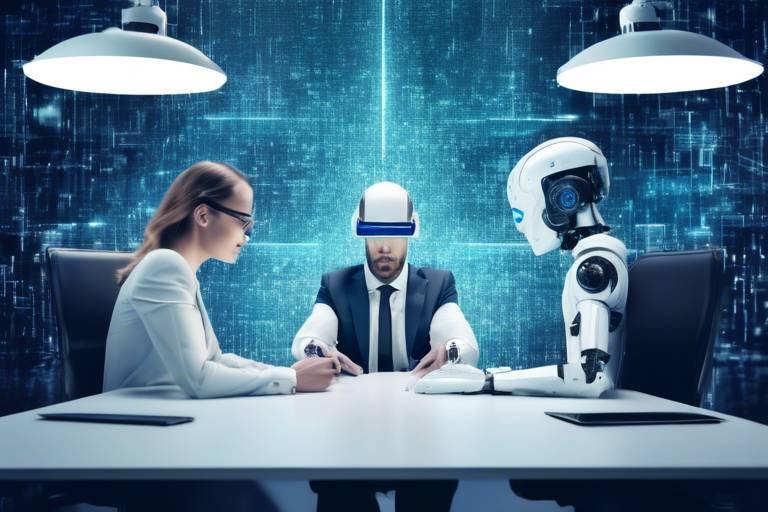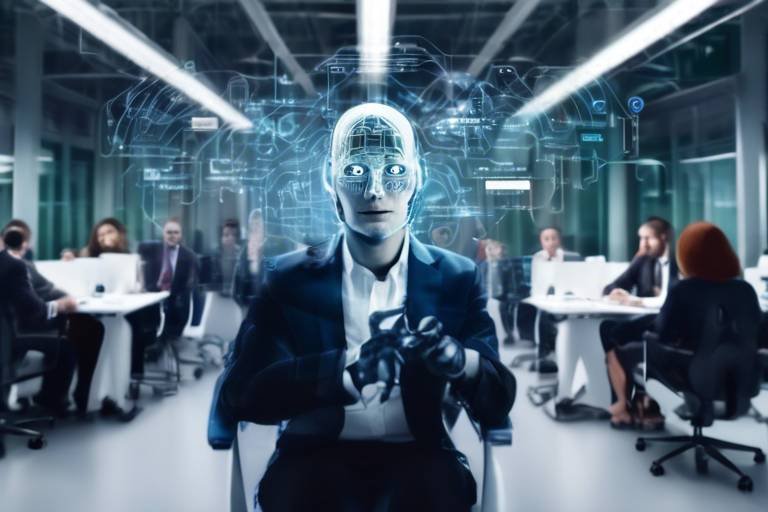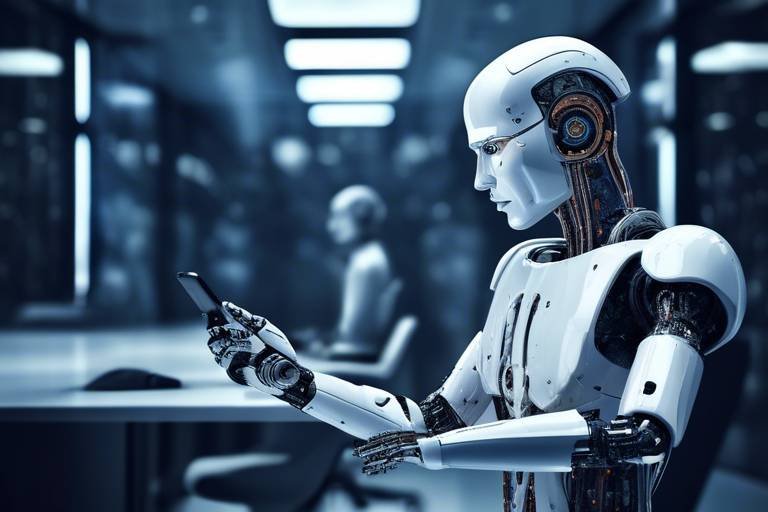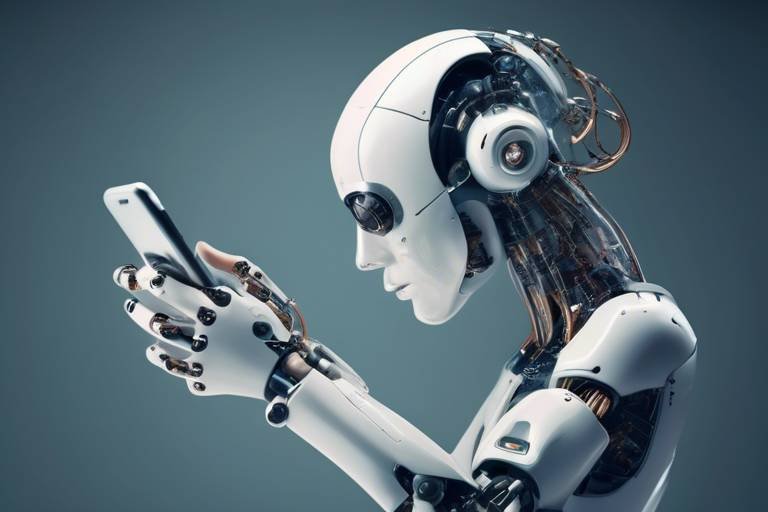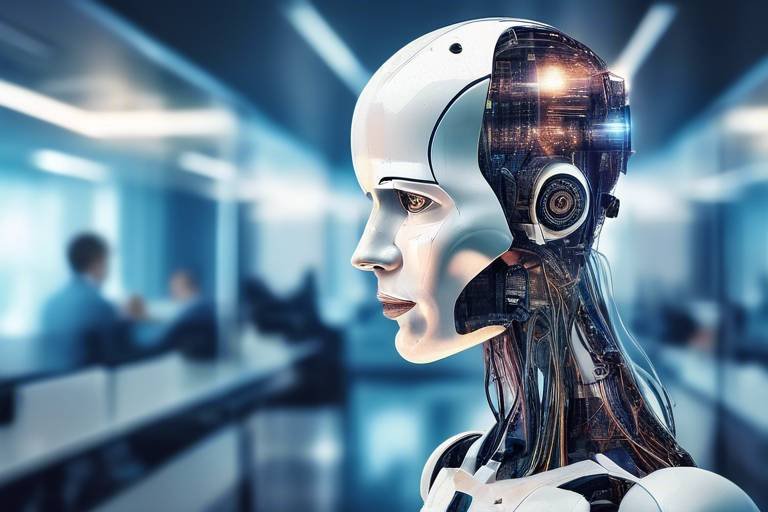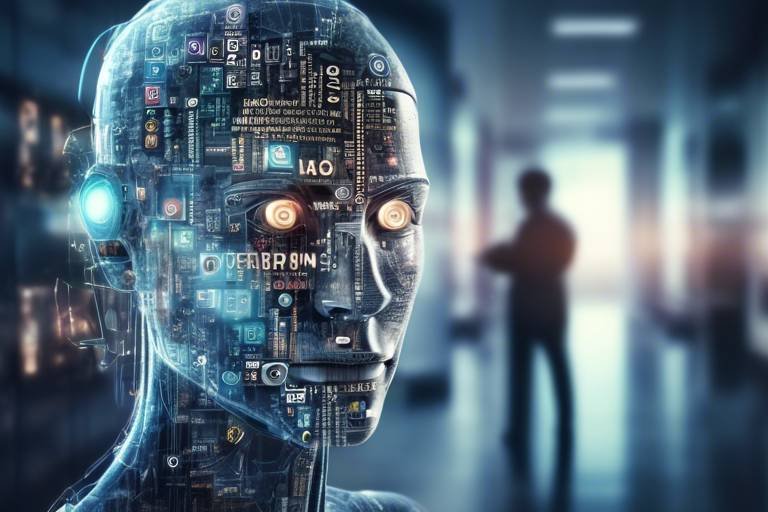Future-proofing Jobs: Embracing AI in the Workplace
The world as we know it is changing at an unprecedented pace, and at the forefront of this transformation is artificial intelligence (AI). It's reshaping industries, redefining job roles, and altering the very fabric of the workplace. But what does this mean for the average worker? Are we looking at a future filled with job losses, or is there a silver lining? As we dive into the intricacies of AI's impact on the job market, it's essential to understand that while some roles may become obsolete, new opportunities are emerging. The key is to embrace change and adapt to the evolving landscape. By understanding the shifts in the labor market, we can better prepare ourselves for the future.
AI's influence on job markets is profound. From automating routine tasks to enhancing decision-making processes, AI is not just a tool; it’s a game-changer. It’s crucial to recognize that AI is reshaping various sectors, including healthcare, finance, and manufacturing. For instance, in healthcare, AI algorithms can analyze medical data faster than any human, leading to quicker diagnoses and improved patient care. However, this advancement also raises concerns about job displacement. Many fear that their roles might be replaced by machines. Yet, history has shown us that while technology can displace jobs, it also creates new ones. The challenge lies in anticipating these changes and preparing for them.
As we navigate this AI-driven world, certain skills are becoming increasingly valuable. Workers must focus on developing both technical and soft skills to remain competitive. Technical skills such as data analysis, programming, and machine learning are at the forefront. But let's not forget the importance of soft skills. In an age where machines can perform tasks, human qualities like creativity, empathy, and communication become critical differentiators. So, what should you focus on? Here’s a closer look at the skills that will be in high demand:
Technical skills are essential for adapting to the demands of an AI-centric workplace. Employees need to be proficient in areas such as:
- Data Literacy: Understanding how to interpret and utilize data effectively is crucial. In a world overflowing with information, being data literate enables employees to make informed decisions that drive business success.
- Programming Basics: Familiarity with programming languages empowers employees to engage with AI tools, fostering innovation and adaptability in their roles.
While technical skills are vital, soft skills like communication, creativity, and emotional intelligence are equally important. They facilitate collaboration and problem-solving in environments increasingly influenced by AI. For instance, a team that communicates effectively can leverage AI tools more efficiently, enhancing overall productivity. Moreover, emotional intelligence allows employees to navigate the complexities of human interactions, fostering a more cohesive work environment.
Employers play a crucial role in facilitating the transition to an AI-driven workplace. They must develop proactive strategies to integrate AI while supporting their workforce. This includes implementing reskilling and upskilling initiatives that help employees transition into new roles. By fostering a culture of continuous learning, employers can ensure that their teams are equipped to handle the demands of an evolving job market.
Training programs focused on reskilling and upskilling are vital. They not only prepare employees for new roles but also instill a sense of confidence and adaptability. Employers should consider:
- Offering workshops on emerging technologies.
- Encouraging participation in online courses and certifications.
- Creating mentorship programs that pair experienced employees with those looking to develop new skills.
A flexible work environment encourages innovation and adaptability. By allowing employees to embrace AI tools and workflows, organizations can enhance productivity and job satisfaction. Flexibility can manifest in various forms, such as remote work options, flexible hours, and collaborative spaces that foster creativity.
Fostering a culture that embraces change and innovation is essential for organizations to thrive in an AI-driven landscape. This cultural shift encourages employees to be open to new technologies and processes, ultimately driving growth and resilience.
Effective leadership is crucial in guiding teams through the transition to AI integration. Leaders must ensure that employees feel supported and empowered to adapt to new challenges. This involves transparent communication about the changes on the horizon and providing resources for employees to grow.
Promoting a culture of innovation and creativity allows employees to explore new ideas and solutions. This not only drives growth but also fosters an environment where employees feel valued and motivated. By encouraging experimentation and risk-taking, organizations can unlock the full potential of their teams.
Q: Will AI take away all jobs?
A: While AI will automate certain tasks, it will also create new job opportunities. The key is to adapt and learn new skills.
Q: What skills should I focus on developing?
A: Focus on both technical skills like data analysis and programming, as well as soft skills like communication and emotional intelligence.
Q: How can employers support their workforce during this transition?
A: Employers can implement reskilling initiatives, create flexible work environments, and foster a culture of continuous learning.

The Impact of AI on Job Markets
Artificial Intelligence (AI) is not just a buzzword; it is a transformative force reshaping the job landscape across various industries. As we dive into the impact of AI on job markets, it’s crucial to understand that while some jobs may become obsolete, new opportunities are also on the horizon. Think of AI as a double-edged sword; it can slice through traditional roles but also carve out new pathways for innovation and growth.
One of the most significant effects of AI is the automation of repetitive tasks. This automation allows employees to focus on more complex and creative aspects of their jobs, enhancing productivity and job satisfaction. For instance, in manufacturing, robots can handle assembly line tasks, freeing human workers to oversee quality control and optimization processes. However, this shift raises an important question: Are workers prepared for the changes that AI brings?
To anticipate job displacement and creation, we must look at various sectors. According to recent studies, the following industries are likely to experience the most significant transformations due to AI:
| Industry | Impact of AI |
|---|---|
| Healthcare | Improved diagnostics and patient care through AI-driven tools. |
| Finance | Automation of trading and personalized financial advice. |
| Retail | Enhanced customer experience with AI chatbots and inventory management. |
| Transportation | Development of autonomous vehicles and smarter logistics. |
As we can see, AI's influence is widespread, and the implications for the workforce are profound. While some jobs may vanish, others will emerge, particularly in fields like data analysis, AI development, and cybersecurity. This shift necessitates a new mindset among workers and employers alike. It’s not just about surviving the changes; it’s about thriving in an AI-driven world.
Moreover, the need for adaptability cannot be overstated. Workers must be willing to learn new skills and embrace technology, while employers should foster an environment that encourages continuous learning. This symbiotic relationship between employees and AI will define the future of work. Are you ready to adapt and embrace these changes?
In conclusion, the impact of AI on job markets is both disruptive and promising. By understanding the potential for job displacement and creation, we can better prepare ourselves for the future. The key takeaway here is that AI is not just a threat; it’s an opportunity for growth, innovation, and a reimagining of what work can be.
- Will AI take away jobs? While AI may automate certain tasks, it will also create new job opportunities that require different skills.
- What skills should I focus on to stay relevant? Focus on developing both technical skills, like data analysis and programming, and soft skills, such as communication and emotional intelligence.
- How can employers support their workforce during this transition? Employers can implement reskilling and upskilling initiatives, create flexible work environments, and foster a culture of innovation.

Essential Skills for the Future Workforce
As we stand on the brink of a new era defined by artificial intelligence, it's crucial to recognize that the future workforce will require a unique blend of skills to navigate this evolving landscape. The ability to adapt and thrive in an AI-driven world isn't just about keeping up with technology; it's about harnessing it to enhance our work and creativity. So, what skills should we be honing to ensure we remain relevant and valuable in our careers? Let's dive into the essential skills that will be in high demand.
First and foremost, technical skills are becoming increasingly indispensable. As AI continues to weave itself into the fabric of various industries, understanding the underlying technologies will set workers apart. Skills such as data analysis, programming, and machine learning are not just buzzwords; they are the tools that will help professionals unlock new opportunities. Imagine being able to analyze vast amounts of data to derive insights that drive business decisions—this is the power of data literacy.
Being data literate means more than just knowing how to read a spreadsheet. It's about interpreting and utilizing data effectively to make informed decisions. In an AI-enhanced workplace, the ability to sift through data and extract meaningful patterns can be the difference between success and stagnation. For instance, a marketing professional who can analyze customer behavior data will be far more effective than one who relies solely on intuition. This skill empowers employees to not only understand their environment but also to drive business success through strategic insights.
Next up is programming basics. While you don't need to become a coding wizard overnight, having a foundational understanding of programming can significantly enhance your ability to work with AI tools. Think of programming as the language of machines; by learning its basics, you can communicate effectively with the technology that increasingly surrounds us. This knowledge fosters innovation and adaptability, allowing you to leverage AI in ways that others might not even consider.
However, it's not all about technical prowess. In fact, as AI takes over more routine tasks, soft skills are becoming even more vital. Skills such as communication, creativity, and emotional intelligence will play a crucial role in collaboration and problem-solving in AI-driven environments. For example, while AI can analyze data, it can't replicate the human touch in understanding client needs or fostering team dynamics. Emotional intelligence allows individuals to navigate interpersonal relationships judiciously and empathetically, enhancing teamwork and collaboration.
To sum it up, the future workforce will require a dynamic skill set that combines both technical and soft skills. Workers who can blend data literacy with emotional intelligence will not only survive but thrive in the AI era. It's about being versatile and adaptable, ready to tackle challenges with a unique perspective. Remember, in a world where machines are getting smarter, the human touch—our creativity, empathy, and critical thinking—will always be our greatest asset.
- What are the essential skills needed for the future workforce?
The essential skills include technical skills like data literacy and programming, as well as soft skills such as communication, creativity, and emotional intelligence.
- How can I improve my data literacy?
You can improve data literacy by taking online courses, participating in workshops, and practicing with real-world data sets to better understand data analysis.
- Is programming necessary for all jobs in the future?
While not all jobs will require advanced programming skills, having a basic understanding of programming can be beneficial in many fields, especially those involving technology.
- Why are soft skills important in an AI-driven workplace?
Soft skills are crucial because they enhance collaboration, creativity, and emotional intelligence, which are areas where humans excel compared to AI.

Technical Skills in Demand
As we navigate through the rapidly evolving landscape of the workforce, it's becoming increasingly clear that certain technical skills are emerging as essential for those looking to stay competitive. With the integration of artificial intelligence into various sectors, employees must arm themselves with knowledge and capabilities that align with this technological shift. Think of it as equipping yourself with a toolbox; the more tools you have, the better prepared you are for any project that comes your way.
Among the most sought-after skills are data analysis, programming, and machine learning. These skills not only enhance individual performance but also contribute to the overall success of an organization. For instance, data analysis allows professionals to sift through vast amounts of information, extracting meaningful insights that can drive strategic decisions. In a world where data is often deemed the new oil, being proficient in this area can set you apart from the competition.
Moreover, programming is another cornerstone skill that is gaining traction. It's not just for software developers anymore; understanding the basics of programming empowers employees across various roles to interact with AI tools effectively. Imagine being able to customize a software solution to meet your specific needs—this is the kind of innovation that comes from having a solid grasp of programming fundamentals.
In addition to these, machine learning is becoming a buzzword in many industries. It refers to the ability of computers to learn from data and improve their performance over time without being explicitly programmed. Employees who can harness machine learning algorithms will be invaluable in driving efficiency and innovation within their organizations. The potential applications are vast, ranging from predictive analytics in marketing to automating mundane tasks in customer service.
| Skill | Description | Importance |
|---|---|---|
| Data Analysis | Interpreting complex data sets to inform business decisions. | High - Vital for strategic planning and operational efficiency. |
| Programming | Writing code to create software applications or tools. | High - Essential for interacting with AI systems and customizing solutions. |
| Machine Learning | Developing algorithms that allow computers to learn from data. | High - Key for automating processes and enhancing decision-making. |
In conclusion, as we embrace an AI-driven future, developing these technical skills will not only enhance your employability but also empower you to contribute meaningfully to your organization. The ability to analyze data, write code, and understand machine learning will be the differentiators that set you apart in a crowded job market. So, are you ready to dive into the world of tech and equip yourself for the future?
- What are the most important technical skills for the future?
The most important technical skills include data analysis, programming, and machine learning. These skills are crucial for adapting to an AI-driven workplace.
- How can I learn these technical skills?
Many online platforms offer courses in data analysis, programming, and machine learning. Websites like Coursera, Udacity, and Khan Academy are excellent resources to get started.
- Is programming only for software developers?
No, programming knowledge is beneficial for various roles across industries, enabling employees to customize tools and automate processes.

Data Literacy
In today's fast-paced, data-driven world, has emerged as a crucial skill for professionals across all industries. But what exactly does it mean to be data literate? At its core, data literacy is the ability to read, understand, create, and communicate data as information. This skill set empowers employees to make informed decisions and drive business success, especially in workplaces increasingly influenced by artificial intelligence.
Imagine walking into a meeting where the discussion revolves around complex data sets. Without data literacy, you might feel lost, like trying to navigate a foreign city without a map. However, with a solid foundation in data literacy, you can interpret charts, analyze trends, and extract meaningful insights that contribute to strategic decision-making. This not only enhances your value as an employee but also positions you as a leader in your organization.
To break it down further, data literacy encompasses several key components:
- Understanding Data Sources: Knowing where data comes from and its reliability.
- Data Analysis: The ability to analyze data and identify patterns or trends.
- Data Visualization: Creating visual representations of data to communicate findings effectively.
- Data Ethics: Understanding the ethical implications of data usage and ensuring compliance with regulations.
As AI continues to evolve, the demand for data-literate professionals will only increase. Companies are looking for individuals who can bridge the gap between raw data and actionable insights. This means that employees who invest time in enhancing their data literacy will not only secure their positions but also open doors to new opportunities in their careers.
Moreover, organizations can play a pivotal role in fostering data literacy among their workforce. By implementing training programs and workshops focused on data interpretation and analysis, employers can equip their employees with the necessary skills to thrive in an AI-driven environment. This proactive approach not only benefits the individuals but also enhances the overall productivity and innovation within the company.
In conclusion, as we continue to embrace the digital age, data literacy stands out as a fundamental skill that every professional should cultivate. By understanding and leveraging data effectively, employees can significantly contribute to their organizations while ensuring they remain relevant in a rapidly changing job market.
- What is data literacy?
Data literacy is the ability to read, understand, create, and communicate data effectively. - Why is data literacy important?
It enables professionals to make informed decisions, enhances their value in the workplace, and prepares them for an AI-driven future. - How can organizations promote data literacy?
By offering training programs, workshops, and resources focused on data analysis and visualization. - What are some key components of data literacy?
Understanding data sources, data analysis, data visualization, and data ethics are crucial components.

Programming Basics
In today's rapidly evolving job market, understanding the basics of programming is no longer just a nice-to-have skill; it's a necessity. Think of programming as the language of technology—just as learning a new spoken language can open doors to different cultures and opportunities, mastering programming can unlock a world of possibilities in the tech-driven landscape we find ourselves in. Whether you're a seasoned professional or just starting out, having a grasp of programming fundamentals can significantly enhance your career prospects and adaptability.
At its core, programming involves writing instructions for computers to perform specific tasks. This can range from simple calculations to complex algorithms that power artificial intelligence systems. The beauty of programming lies in its versatility; it can be applied in numerous fields, from finance to healthcare, making it an essential skill across industries. But where do you start?
First, it's important to familiarize yourself with some key concepts:
- Syntax: Just like grammar in a spoken language, syntax refers to the set of rules that defines the combinations of symbols that are considered to be correctly structured programs.
- Variables: These are containers for storing data values. Understanding how to use variables effectively allows you to manipulate data within your programs.
- Control Structures: These include if statements and loops that control the flow of execution in a program, enabling you to create dynamic and responsive applications.
- Functions: Functions are reusable pieces of code that perform a specific task. Learning how to write and utilize functions helps streamline your code and makes it easier to manage.
Moreover, there are various programming languages to choose from, each with its own strengths and applications. For instance, Python is known for its simplicity and readability, making it a great choice for beginners. On the other hand, JavaScript is essential for web development, allowing you to create interactive websites. Here’s a quick comparison of some popular programming languages:
| Language | Best For | Learning Curve |
|---|---|---|
| Python | Data Science, Web Development | Easy |
| JavaScript | Web Development | Moderate |
| Java | Enterprise Applications | Moderate |
| C++ | System Programming, Game Development | Hard |
Ultimately, learning programming basics is about fostering a mindset of problem-solving and creativity. It's not just about writing code; it's about thinking logically and systematically to tackle challenges. As you embark on this journey, remember that practice is key. Start with small projects, gradually increasing complexity as you gain confidence. There are countless resources available online, from free courses to coding bootcamps, that can help you along the way.
In a world where AI is becoming increasingly prevalent, understanding programming basics will empower you to engage with these technologies effectively. You'll not only be able to utilize AI tools but also contribute to their development and innovation. So, dive in, embrace the challenge, and watch as new career opportunities unfold before you!
1. Do I need a degree to learn programming?
No, many successful programmers are self-taught. There are plenty of online resources and courses available.
2. What programming language should I start with?
Python is often recommended for beginners due to its simplicity and versatility.
3. How long does it take to learn programming?
It varies by individual, but with consistent practice, you can grasp the basics in a few months.
4. Can programming skills help in non-tech jobs?
Absolutely! Many industries value programming skills for data analysis, automation, and problem-solving.

Soft Skills and Emotional Intelligence
As we navigate the rapidly evolving landscape of the workplace, the importance of soft skills and emotional intelligence cannot be overstated. While technical abilities are essential, they are often not enough on their own. In an age where artificial intelligence is taking over many routine tasks, the human touch becomes invaluable. Think about it: can a machine truly understand the nuances of human emotion? The answer is a resounding no. This is where soft skills come into play, acting as the glue that holds teams together and fosters collaboration.
Soft skills encompass a range of abilities that facilitate effective communication and collaboration. These skills include communication, creativity, problem-solving, and adaptability. For instance, when teams face challenges, those with strong emotional intelligence can navigate through conflicts with empathy and understanding, ensuring that everyone feels heard and valued. In contrast, individuals lacking these skills may struggle to connect with their colleagues, leading to a breakdown in teamwork.
Moreover, emotional intelligence—the ability to recognize, understand, and manage our own emotions and the emotions of others—plays a critical role in the workplace. It allows employees to build stronger relationships, resolve conflicts, and create a positive work environment. Imagine a scenario where a team is under pressure to meet a deadline. A leader with high emotional intelligence can sense the stress levels of their team members and offer support, perhaps by reallocating tasks or providing encouragement. This not only boosts morale but also enhances productivity.
To further illustrate the importance of these skills, consider the following table that outlines the key differences between technical skills and soft skills:
| Technical Skills | Soft Skills |
|---|---|
| Specific knowledge related to a task or job | Interpersonal abilities that enhance teamwork and communication |
| Often quantifiable and measurable | More subjective and harder to evaluate |
| Examples include programming, data analysis, and technical writing | Examples include empathy, adaptability, and conflict resolution |
In summary, as we step into an AI-driven future, the ability to connect with others and navigate social complexities will become increasingly vital. Employers should prioritize hiring individuals who not only possess technical expertise but also demonstrate strong soft skills and emotional intelligence. After all, it’s these qualities that will enable teams to thrive in a collaborative environment, fostering innovation and resilience in the face of change.
- What are soft skills? Soft skills are personal attributes that enable someone to interact effectively with others. They include communication, teamwork, and problem-solving abilities.
- Why is emotional intelligence important in the workplace? Emotional intelligence helps individuals manage their emotions and understand the emotions of others, fostering better relationships and teamwork.
- How can I improve my soft skills? You can enhance your soft skills through practice, seeking feedback, and engaging in activities that require collaboration and communication.
- Are soft skills more important than technical skills? While technical skills are essential, soft skills are increasingly recognized as crucial for long-term success in the workplace.

Strategies for Employers to Adapt
In today's rapidly changing job landscape, employers are faced with the challenge of integrating artificial intelligence into their organizations while ensuring their workforce remains engaged and capable. The key to successfully navigating this transition lies in developing proactive strategies that not only embrace AI technologies but also support employees in adapting to these changes. By fostering a culture of continuous learning and innovation, employers can create an environment where both the organization and its employees can thrive.
One of the most effective strategies is to implement reskilling and upskilling initiatives. These programs focus on equipping employees with the necessary skills to transition into new roles that may arise due to AI integration. This approach not only enhances the workforce's capabilities but also boosts employee morale, as individuals feel valued and invested in their professional growth. For instance, companies can offer workshops, online courses, and mentorship opportunities that focus on the skills that are becoming increasingly relevant in the AI-driven workplace.
Moreover, creating a flexible work environment is crucial for promoting innovation and adaptability. Flexibility can manifest in various forms, such as remote work options, flexible hours, and the freedom to explore new workflows and tools. This autonomy allows employees to embrace AI technologies more readily, enhancing their productivity and job satisfaction. When employees feel empowered to experiment with different approaches, they are more likely to develop innovative solutions that can benefit the organization as a whole.
To further support their workforce, employers should focus on fostering a culture that embraces change and innovation. This cultural shift involves encouraging employees to be open to new technologies and processes, which can be achieved through regular communication and transparency about the company's vision for AI integration. Leadership plays a pivotal role in this transition; effective leaders must guide their teams through the challenges of adapting to AI, ensuring that employees feel supported and empowered to tackle new obstacles. By demonstrating a commitment to innovation and providing the necessary resources, leaders can inspire their teams to embrace change rather than resist it.
In addition to these strategies, promoting innovation and creativity within the workplace can lead to significant benefits. Employers can create opportunities for brainstorming sessions, hackathons, or innovation labs where employees can collaborate on new ideas and solutions. This not only fosters a sense of community but also drives growth and resilience in an AI-enhanced workplace. When employees are encouraged to think outside the box, they are more likely to contribute to the organization’s success in meaningful ways.
To summarize, adapting to the AI-driven landscape requires a multifaceted approach that includes:
- Reskilling and Upskilling Initiatives: Providing training programs to help employees transition to new roles.
- Creating a Flexible Work Environment: Encouraging autonomy and adaptability in workflows.
- Fostering a Culture of Change: Supporting employees through transparent communication and effective leadership.
- Encouraging Innovation: Creating opportunities for collaboration and creative problem-solving.
By implementing these strategies, employers can not only adapt to the changes brought about by AI but also cultivate a workforce that is resilient, skilled, and ready to tackle the challenges of the future.
Q: How can employers identify the skills needed for AI integration?
A: Employers can conduct a skills gap analysis by evaluating current employee skills against the demands of AI technologies. Collaborating with industry experts and participating in workforce development initiatives can also provide insights into the skills that will be in high demand.
Q: What are some effective ways to promote a culture of continuous learning?
A: Employers can promote continuous learning by offering various professional development opportunities, such as workshops, online courses, and access to learning platforms. Encouraging employees to share knowledge and experiences can also foster a learning culture.
Q: How can companies measure the success of their reskilling initiatives?
A: Companies can measure the success of reskilling initiatives through key performance indicators (KPIs), such as employee retention rates, productivity levels, and the number of employees successfully transitioning to new roles. Regular feedback from employees can also provide valuable insights.

Reskilling and Upskilling Initiatives
As we navigate the rapidly evolving landscape of the workplace, the importance of reskilling and upskilling initiatives cannot be overstated. With artificial intelligence reshaping job roles and responsibilities, organizations must proactively address the skills gap that is emerging. This isn't just about keeping up; it’s about staying ahead. Imagine a ship sailing through uncharted waters—without the right navigational tools, it risks capsizing. Similarly, businesses that fail to invest in employee development may find themselves struggling to adapt in an AI-driven world.
Reskilling refers to teaching employees new skills to transition into different roles, while upskilling focuses on enhancing existing skills. Both strategies are essential for fostering a workforce that is not only competent but also confident in their abilities to leverage AI technologies. Companies that prioritize these initiatives create an environment where employees feel valued and empowered, which in turn boosts morale and productivity.
For instance, let’s consider a traditional manufacturing company that integrates AI into its production line. Workers may need to learn how to operate new machinery or analyze data generated by AI systems. This is where targeted training programs come into play. By offering workshops, online courses, and hands-on training sessions, companies can equip their employees with the necessary skills to thrive in their roles. Moreover, these programs can be tailored to meet the specific needs of the organization, ensuring that employees receive relevant and practical knowledge.
To illustrate the impact of effective reskilling and upskilling initiatives, we can look at a few key benefits:
- Increased Employee Retention: Employees are more likely to stay with a company that invests in their professional growth.
- Enhanced Productivity: A skilled workforce can operate more efficiently, leading to improved overall performance.
- Greater Innovation: Employees who are continually learning are more likely to contribute fresh ideas and creative solutions.
In addition to structured training programs, organizations should foster a culture of continuous learning. This can be achieved by encouraging employees to pursue self-directed learning opportunities, such as online courses or industry certifications. Providing access to resources like e-learning platforms or mentorship programs can further support this initiative. When employees are given the tools and freedom to learn, they often exceed expectations, bringing new insights and skills to the table.
Moreover, collaboration between employers and educational institutions can enhance these initiatives. By partnering with universities and vocational schools, companies can help design curricula that align with industry needs, ensuring that new graduates are job-ready. This collaboration not only benefits the organization but also contributes to the broader community by preparing a skilled workforce for the future.
In summary, reskilling and upskilling initiatives are not just a response to the challenges posed by AI; they are a strategic advantage that companies can leverage to ensure long-term success. By investing in their workforce, organizations can create a resilient environment that embraces change and innovation, ultimately paving the way for a brighter future in the age of artificial intelligence.
1. What is the difference between reskilling and upskilling?
Reskilling involves teaching employees new skills for different roles, while upskilling enhances existing skills to improve performance in their current roles.
2. How can companies implement effective reskilling initiatives?
Companies can implement effective reskilling initiatives by offering targeted training programs, workshops, and online courses tailored to their specific needs.
3. Why is a culture of continuous learning important?
A culture of continuous learning is important because it encourages employees to keep developing their skills, leading to increased innovation, productivity, and employee retention.
4. How can organizations collaborate with educational institutions?
Organizations can collaborate with educational institutions by partnering to design relevant curricula, offering internships, and providing mentorship opportunities for students.

Creating a Flexible Work Environment
In today’s fast-paced world, creating a flexible work environment is not just a luxury; it's a necessity. As artificial intelligence continues to reshape the workplace, organizations must adapt by offering flexibility that meets the diverse needs of their employees. Imagine a workplace where you can choose when and where to work, allowing you to balance your personal life and professional responsibilities seamlessly. This kind of flexibility not only enhances employee satisfaction but also boosts productivity and creativity.
Flexibility can take many forms, from remote work options to flexible hours. By empowering employees to tailor their work schedules, companies can foster a sense of trust and autonomy. This shift not only leads to higher retention rates but also encourages employees to take ownership of their work. In a world where AI tools can assist with tasks, the human element—creativity, emotional intelligence, and problem-solving—becomes even more valuable. When employees feel comfortable and supported, they are more likely to engage with AI technologies and use them to enhance their performance.
To effectively implement a flexible work environment, organizations can consider the following strategies:
- Remote Work Policies: Establish clear guidelines for remote work that outline expectations, communication protocols, and performance metrics. This ensures that employees remain accountable while enjoying the benefits of working from home.
- Flexible Hours: Allow employees to choose their working hours, enabling them to work during their most productive times. This can lead to improved work-life balance and greater job satisfaction.
- Collaborative Tools: Invest in technology that facilitates collaboration among team members, whether they are in the office or working remotely. Tools like video conferencing, project management software, and instant messaging platforms can bridge the gap between remote and in-office employees.
Moreover, it’s essential to cultivate a culture that embraces flexibility. This means encouraging open communication and feedback, where employees feel comfortable sharing their thoughts on what works for them. Regular check-ins can help leaders gauge employee satisfaction and make necessary adjustments. By prioritizing flexibility, organizations can create an environment that not only attracts top talent but also retains them.
In conclusion, a flexible work environment is about more than just remote work or adjustable hours; it's about fostering a culture of trust, collaboration, and innovation. As we embrace the future of work shaped by AI, organizations that prioritize flexibility will undoubtedly thrive. After all, in a world where change is the only constant, adaptability is key.
- What are the benefits of a flexible work environment?
A flexible work environment can lead to increased employee satisfaction, higher productivity, and better work-life balance. - How can companies implement flexible work policies?
Companies can start by establishing clear remote work guidelines, allowing flexible hours, and investing in collaborative technology. - What role does communication play in a flexible work environment?
Open communication is crucial for ensuring that employees feel supported and engaged, regardless of where they work.

Embracing Change: A Cultural Shift
In today's rapidly evolving workplace, embracing change is not just a buzzword; it’s a necessity. Organizations that foster a culture of innovation and adaptability are better equipped to navigate the complexities of an AI-driven landscape. Imagine a ship sailing through turbulent waters—those that can adjust their sails will not only survive but thrive. The key to this adaptability lies in cultivating an environment where employees feel empowered to embrace new technologies and processes.
At the heart of this cultural shift is a mindset that values learning and growth. Employees should be encouraged to explore new ideas without the fear of failure. After all, failure is often the first step toward innovation. Companies can facilitate this by creating platforms for collaboration, where teams can brainstorm, experiment, and share insights. Think of it as a creative playground—one where every idea, no matter how unconventional, is welcomed and explored.
Moreover, effective leadership plays a crucial role in guiding teams through this transition. Leaders must not only communicate the vision of an AI-integrated future but also actively participate in the learning process alongside their teams. This approach fosters trust and demonstrates that everyone, regardless of their position, is on the same journey. A leader who is willing to learn and adapt sets a powerful example, inspiring others to do the same.
To further support this cultural shift, organizations can implement regular training sessions and workshops focused on emerging technologies and trends. These initiatives not only enhance employees' skill sets but also promote a sense of belonging and community within the workplace. When individuals feel that their growth is prioritized, they are more likely to engage with new technologies enthusiastically.
Finally, it’s essential to recognize that embracing change is not a one-time event but an ongoing process. Organizations should regularly assess their cultural practices and be open to adjustments as new challenges arise. This flexibility ensures that the workforce remains resilient and prepared for whatever the future holds. In this dynamic environment, innovation becomes part of the organizational DNA, driving continuous improvement and success.
- Why is embracing change important in the workplace?
Embracing change allows organizations to adapt to new technologies, market demands, and competitive pressures, ensuring long-term sustainability and growth. - How can companies foster a culture of innovation?
Companies can foster innovation by encouraging open communication, providing training opportunities, and creating collaborative environments where employees feel safe to share ideas. - What role does leadership play in cultural change?
Effective leadership is crucial in guiding teams through transitions, as leaders set the tone for the organization and inspire employees to embrace new challenges.

Leadership in the Age of AI
In this rapidly evolving landscape dominated by artificial intelligence, the role of leadership is undergoing a profound transformation. Leaders today are not just managers; they are visionaries who must navigate their teams through the complexities of an AI-enhanced workplace. But what does effective leadership look like in the age of AI? Well, it’s all about understanding, adapting, and empowering. Leaders need to cultivate an environment where technology and human creativity coexist harmoniously.
One of the most significant shifts is the emphasis on collaboration. AI tools can analyze vast amounts of data and provide insights that were previously unimaginable, but they lack the human touch. This is where leaders come in. They must encourage their teams to leverage AI while fostering a culture of teamwork and communication. Imagine a symphony orchestra: while each musician plays their part, it’s the conductor who ensures that the music flows seamlessly. Similarly, leaders must orchestrate the integration of AI, guiding their teams to work in sync with these powerful tools.
Moreover, transparency is key. Employees need to understand how AI is impacting their roles and the organization as a whole. By maintaining open lines of communication, leaders can alleviate fears associated with job displacement. Instead of viewing AI as a threat, employees can see it as an opportunity for growth. This can be achieved through regular updates, training sessions, and forums where team members can voice their concerns and ideas. When employees feel heard and valued, they are more likely to embrace change with enthusiasm.
Another crucial aspect of leadership in the age of AI is emotional intelligence. Leaders must be attuned to the feelings and motivations of their teams, especially as they navigate the uncertainties brought on by technological advancements. By demonstrating empathy and understanding, leaders can build trust and foster a supportive work environment. This emotional connection can lead to increased employee morale and productivity, as team members feel more secure in their roles.
Lastly, leaders should prioritize continuous learning. With AI evolving at breakneck speed, staying updated on the latest trends and technologies is vital. Leaders should not only invest in their own learning but also promote a culture of curiosity within their teams. This can be done through workshops, online courses, and collaborative projects that encourage experimentation and innovation. By fostering a mindset of lifelong learning, organizations can remain agile and responsive to the ever-changing demands of the market.
In summary, effective leadership in the age of AI requires a blend of collaboration, transparency, emotional intelligence, and a commitment to continuous learning. Leaders who embrace these principles will not only guide their teams through the challenges of AI integration but will also inspire them to thrive in this new era.
- How can leaders effectively communicate the benefits of AI to their teams? Leaders should hold regular meetings to discuss AI's impact, share success stories, and provide training sessions to help employees understand AI tools.
- What role does emotional intelligence play in AI leadership? Emotional intelligence helps leaders connect with their teams, building trust and understanding during times of change.
- How important is continuous learning for leaders in the AI era? Continuous learning is crucial as it keeps leaders informed about the latest AI developments, allowing them to make better decisions and guide their teams effectively.

Encouraging Innovation and Creativity
In today's fast-paced world, where artificial intelligence is becoming an integral part of our work environment, fostering a culture of innovation and creativity is more important than ever. Organizations that encourage their employees to think outside the box not only enhance productivity but also drive growth and resilience. So, how can companies cultivate this innovative spirit? It starts with creating an atmosphere where employees feel safe to express their ideas and take risks without the fear of failure. After all, isn't innovation often born from trial and error?
One effective way to promote creativity is by implementing brainstorming sessions that allow team members to collaborate and share their thoughts openly. These sessions can be structured or unstructured, depending on what works best for the team. The key is to encourage participation from everyone, regardless of their position within the organization. When employees feel valued and heard, they are more likely to contribute unique ideas that can lead to breakthrough innovations.
Moreover, organizations can benefit from establishing innovation labs or dedicated spaces where employees can experiment with new technologies and ideas without the constraints of their daily tasks. These labs serve as incubators for creativity, enabling teams to explore new concepts, test prototypes, and develop solutions that could transform the business. By providing the right tools and resources, companies can empower their workforce to think creatively and push boundaries.
Another crucial aspect of encouraging innovation is recognizing and rewarding creative efforts. Celebrating successes, no matter how small, can motivate employees to continue thinking creatively. This can be done through incentive programs, recognition awards, or even simple shout-outs during team meetings. When employees see that their innovative contributions are appreciated, it fosters a sense of ownership and pride in their work.
Lastly, it’s essential to integrate diversity and inclusion into the workplace. Bringing together individuals from different backgrounds, experiences, and perspectives can spark creativity and lead to innovative solutions. Diverse teams are often more adept at problem-solving because they approach challenges from various angles. So, let’s embrace diversity as a catalyst for innovation!
- How can I encourage my team to be more innovative?
Start by creating an open environment where all ideas are welcome. Implement brainstorming sessions and provide resources for experimentation. - What role does leadership play in fostering creativity?
Effective leaders inspire and support their teams, encouraging them to take risks and think creatively. - How important is diversity in promoting innovation?
Diversity brings different perspectives, which can lead to more creative solutions and innovative ideas. - What are some ways to reward creativity in the workplace?
Consider implementing recognition programs, incentive rewards, or simply acknowledging creative efforts in team meetings.
Frequently Asked Questions
- How is AI impacting job markets?
AI is revolutionizing job markets by automating routine tasks, which can lead to job displacement in some sectors. However, it also creates new opportunities in fields like data analysis, programming, and AI maintenance. Understanding these shifts helps workers prepare for the evolving demands of the labor market.
- What essential skills will be in demand in the future?
As we move towards an AI-driven workplace, both technical and soft skills will be crucial. Technical skills such as data literacy, programming, and machine learning will be highly valued, while soft skills like communication, creativity, and emotional intelligence will enhance collaboration and problem-solving.
- What is data literacy and why is it important?
Data literacy refers to the ability to read, understand, create, and communicate data. In an AI-enhanced workplace, being data literate enables employees to make informed decisions, drive business success, and leverage data for strategic advantages.
- How can employers support their workforce in adapting to AI?
Employers can implement reskilling and upskilling initiatives, creating training programs that equip employees with necessary skills. Additionally, fostering a flexible work environment encourages innovation and allows employees to adapt to new AI tools and workflows.
- What role does leadership play in the transition to AI?
Effective leadership is essential during the transition to AI integration. Leaders must guide their teams, ensuring employees feel supported and empowered to adapt to new challenges, ultimately fostering a culture of innovation and resilience.
- How can organizations foster a culture of innovation?
Organizations can encourage innovation by promoting a culture that values creativity and new ideas. This can be achieved through open communication, collaboration, and providing resources for employees to explore and implement innovative solutions.






